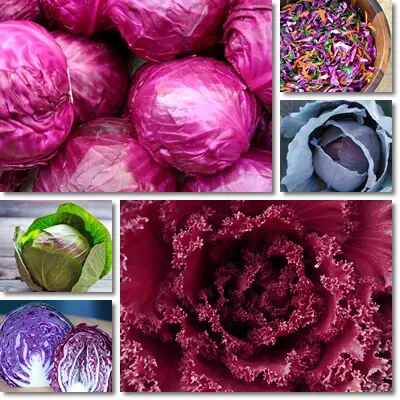Red cabbage is a red or purple-colored variety of cabbage (scientific name: Brassica oleracea capitata rubra). It’s known for being especially good for health, but what exactly is it good for? Most people know the cruciferous vegetable to have anticancer and prebiotic properties and cause gas. But red cabbage also has a beneficial impact on inflammatory digestive and even autoimmune conditions, lowers blood pressure and is a good food to eat during pregnancy, with benefits for both mother and baby health. Find out the following 7 amazing, yet lesser known benefits of red cabbage:
1) Benefits for digestive and autoimmune conditions
Red cabbage is a prebiotic, that is, a food that induces the growth of beneficial bacteria and helps build healthy bacteria populations in the human gastrointestinal tract. It does so through indigestible components such as dietary fiber of the likes of raffinose, for example. Raffinose sustains Lactobacillus, Bifidobacterium and other beneficial bacteria with varied benefits for the GI tract and overall health.
Studies show a healthy gut flora holds benefits for digestive conditions such as irritable bowel syndrome and ulcerative colitis, but also non-digestive immune system-mediated conditions such as atopic dermatitis in terns of occurrence, recurrence and severity of symptoms.

2) Promotes intestinal health
Raw and cooked red cabbage is a prebiotic, meaning it serves as food for gut bacteria. Fermented or soured red cabbage is also a probiotic, meaning it contains live beneficial bacteria that actively progress gastrointestinal health. Eating red cabbage helps build and sustain healthy populations of beneficial microorganisms in the GI tract which, in turn, creates a favorable medium that inhibits the growth of pathogenic bacteria, helps with the innate production of essential vitamins, optimizes nutrient uptake and use and helps restore gut flora populations following antibiotic use.
A healthy gut medium is believed to hold benefits for inflammatory digestive conditions such as ulcerative colitis and even immune system mediated conditions such as atopic dermatitis, and also suppresses enzymatic reactions that could create carcinogens that cause cancer. So what if eating red or purple or green or white cabbage gives you gas? That’s actually a good sign, a sign of fermentation from bacteria feeding which, in time, will create a hospitable medium conducive of gastrointestinal health.
3) Benefits for diabetes
Because it tastes somewhat sweet, a lot of people wonder if red cabbage is a good food to eat for diabetes. Is red cabbage high in sugar? Here are the facts: a serving of 100 g of raw, red cabbage provides about 7.4 g of carbs of which roughly 3.8 g are sugar and 2.1 g dietary fiber. But red cabbage GI index is estimated at 15-20 which is not just low, but very low which means is has limited effects on blood sugar levels, when consumed in reasonable amounts.
The GI, or glycemic index, is a scale that measures how fast that carbohydrates in a food raise blood sugar levels. Below 55 is a low GI. Between 56-69 is a moderate GI. Between 70-100 (sometimes higher) is a high GI. The lower the GI value of a food, the lesser its impact on blood sugar, which is an important aspect of diabetic nutrition. So while red cabbage does have sugar, its overall carbohydrate content is low enough to not impact blood sugar levels significantly, provided intake is reasonable. Which makes it a good food to eat for diabetes and prediabetes.

4) Benefits for easy bruising and bleeding
Did you know that red cabbage is high in vitamins C and K? A serving of 100 g of raw, red cabbage provides 57 milligrams (mg) of vitamin C out of a recommended daily intake of 90 mg for men and 75 mg of women. The same amount provides 38.2 micrograms (mcg) of vitamin K out of a recommended daily intake of 120 mcg for men and 90 mcg for women. While vtamin K supports blood coagulation processes, vitamin C strengthens capillary walls, preventing easy bruising and bleeding.
Vitamin C also stimulates the production of collagen, a protein that provides structure to connective tissues in the body, skin included which is important for tissue repair. Through its immunomodulating effects, vitamin C in red cabbage further reduces inflammation which allows for tissues regeneration and wound healing. Find out more about the benefits of vitamin C for wound healing.
5) Benefits for high blood pressure
While it’s not one of the best foods to eat for high blood pressure, red cabbage does provide some benefits for the condition. For one, a serving of 200 g of raw, red cabbage provides 486 mg of potassium, which is roughly 10% of the recommended daily intake of the mineral. Potassium maintain the electrolyte balance in the blood and relieves pressure in blood vessels which results in lower blood pressure numbers.
Red cabbage is also a modest source of magnesium and the antioxidant lycopene which further help lower high blood pressure numbers. Studies show a high intake of lycopene can help lower both systolic and diastolic blood pressure by 9 and 7 points (in grade I hypertension: 120/80 or 130/90 up to 159/99 mm/Hg). Watermelon, tomatoes, pink grapefruit, guava, rose hip berries, red bell peppers and red carrots, but also gac fruit are some of the best sources of lycopene.
6) Good for pregnant women
Pregnancy oversee a natural change in intestinal motility and bowel habits that often leads to constipation. Red cabbage is a great source of fiber and can help improve bowel function and relieve constipation. Also, red cabbage is a good source of potassium which helps with pregnancy-associated high blood pressure, as well as contains modest amounts of other anti-hypertensive components such as magnesium and lycopene.
Red cabbage is further a good source of vitamin B6 – a serving of 100 g of raw red cabbage provides 0.209 mg of vitamin B6 which is the equivalent of about 16% of the recommended daily intake for the average adult. Vitamin B6 contributes to the synthesis of hemoglobin, the oxygen-carrying protein in red blood cells. A sufficient intake of the vitamin helps attenuate symptoms related to anemia such as tiredness, fatigue and muscle weakness.
Lastly, red cabbage is a modest source of folate or vitamin B9 as well as other B vitamins which are required for the normal development of the baby during pregnancy.
7) Benefits for atherosclerosis
Multiple constituents in red cabbage benefit cardiovascular health in atherosclerotic disease. Vitamin C promotes the synthesis of collagen, a structural protein that confers flexibility to blood vessel walls. Vitamin C also helps keep arteries clean and clear plaque from artery walls, which is a major benefit for the prevention of atherosclerosis. Furthermore, constituents specific to cabbage vegetables such as indole-3-carbinol have proven anti-atherogenic properties, meaning they help prevent lipid plaques on the inside of artery walls that lead to the development of atherosclerosis and heart disease. Red cabbage is also low in calories, carbs, sugar and fat and a good source of dietary fiber and helps maintain a healthy weight and cardiovascular health.
